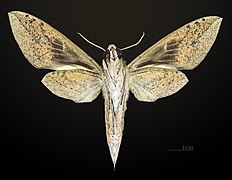
Theretra oldenlandiae, the impatiens hawkmoth, taro hornworm or white-banded hunter hawkmoth, is a member of the family Sphingidae.
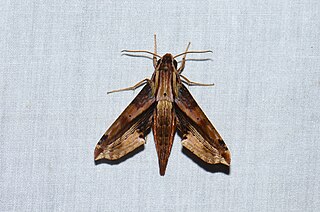
Eupanacra mydon, the common rippled hawkmoth, is a moth of the family Sphingidae.

Theretra latreillii, the pale brown hawk moth, is a moth of the family Sphingidae described by William Sharp Macleay in 1826. It is found in most of Asia, including Borneo, China, Hong Kong, the Philippines, Taiwan and also throughout the tropical and temperate regions of Australia.

Theretra nessus, the yam hawk moth, is a moth of the family Sphingidae. It was described by Dru Drury in 1773.

Theretra silhetensis, the brown-banded hunter hawkmoth, is a moth of the family Sphingidae described by Francis Walker in 1856. It lives in Indo-Australia, India, Sri Lanka, Papua New Guinea, East Australia, Solomon Islands, Fiji Islands, Vanuatu Islands.

Hippotion rosetta, or Swinhoe's striated hawkmoth, is a species of sphingid moth in the family Sphingidae. The species was first described by Charles Swinhoe in 1892.

Macroglossum divergens, the broad-bordered hummingbird hawkmoth, is a moth of the family Sphingidae. It was described by Jean Baptiste Boisduval in 1875. It is found from north-eastern Sikkim, India across southern China to Cheju Island, southern Japan, Taiwan and the Philippines and then south through Vietnam, Thailand, Malaysia and Indonesia to New Guinea and neighbouring islands. It may be in Sri Lanka.

Theretra japonica is a moth of the family Sphingidae first described by Jean Baptiste Boisduval in 1869.
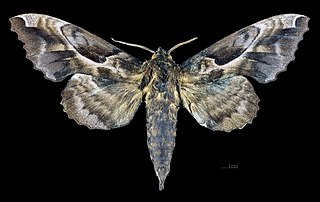
Phyllosphingia is a monotypic moth genus in the family Sphingidae erected by Charles Swinhoe in 1897. Its only species, Phyllosphingia dissimilis, the buff-leaf hawkmoth, was described by Otto Vasilievich Bremer in 1861.

Pergesa is a monotypic moth genus in the family Sphingidae first described by Francis Walker in 1856. Its only species, Pergesa acteus, the green pergesa hawkmoth, was described by Pieter Cramer in 1779.

Theretra alecto, the Levant hawk moth, is a moth of the family Sphingidae. The species was first described by Carl Linnaeus in his 1758 10th edition of Systema Naturae.

Amplypterus panopus, the mango hawkmoth, is a moth of the family Sphingidae. The species was first described by Pieter Cramer in 1779. It is found in Sri Lanka, southern and northern India, Nepal, Myanmar, southern China, Thailand, Vietnam, Laos, Indonesia and the Philippines.
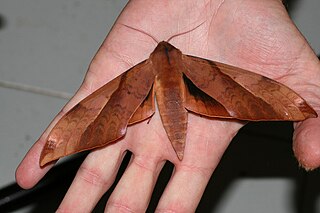
Clanis undulosa, the wavy velvet hawkmoth, is a moth of the family Sphingidae first described by Frederic Moore in 1879. The nominate subspecies is found in the southern Russian Far East, the Korean Peninsula and north-eastern China, as far as south and west as Shaanxi and Hebei. South from Sichuan (Baoxing), Hubei, Jiangxi (Guling) and Zhejiang, it is replaced by ssp. gigantea, which ranges west to Nepal and south, through Thailand and Vietnam, to Peninsular Malaysia.

Acosmeryx naga is a moth of the family Sphingidae. It was described by Frederic Moore in 1858, and is known from Japan, Tajikistan, Afghanistan, China and South-east Asia.
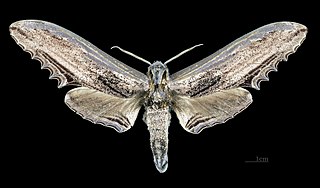
Langia zenzeroides, the apple hawkmoth, is a species of moth in the family Sphingidae. It was described by Frederic Moore in 1872.
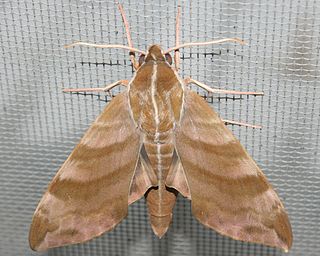
Ampelophaga rubiginosa is a moth of the family Sphingidae. It was described by Otto Vasilievich Bremer and William (Vasilii) Grey in 1853. It is found from north-eastern Afghanistan, east around the southern margin of the Himalaya to Yunnan, then throughout China to the Russian Far East, the Korean Peninsula and Japan. It is also found south through Thailand and Vietnam to Sumatra and Peninsular Malaysia.
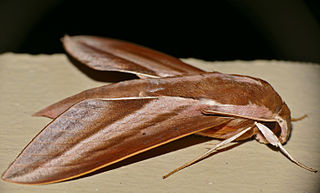
Theretra suffusa is a moth of the family Sphingidae.

Theretra pallicosta, the white-edged hunter hawkmoth, is a moth of the family Sphingidae described by Francis Walker in 1856. It is found from Sri Lanka and India, east through Nepal, Bangladesh and Myanmar to Hong Kong and Taiwan and south through Thailand, Laos and Vietnam to Peninsular Malaysia and Indonesia.
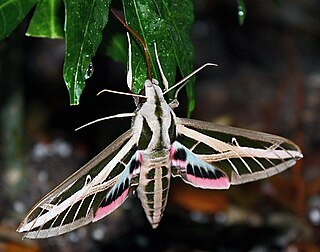
Eumorpha fasciatus, the banded sphinx, is a moth of the family Sphingidae. The species was first described by Johann Heinrich Sulzer in 1776.

Meganoton analis, the grey double-bristled hawkmoth, is a moth of the family Sphingidae. It is known from India, Nepal, southern and eastern China, northern Thailand, northern Vietnam, Peninsular Malaysia, Indonesia, Taiwan, the southern part of the Russian Far East, South Korea and Japan.


